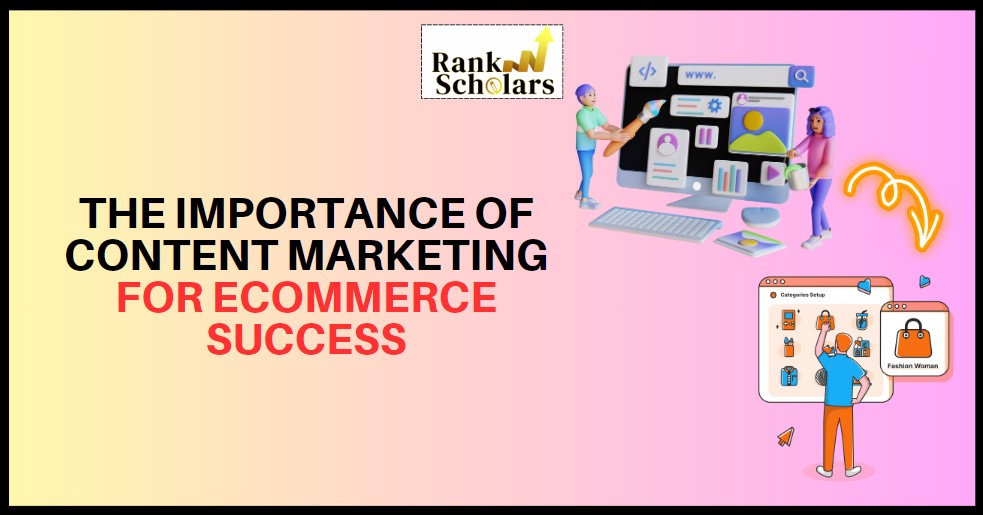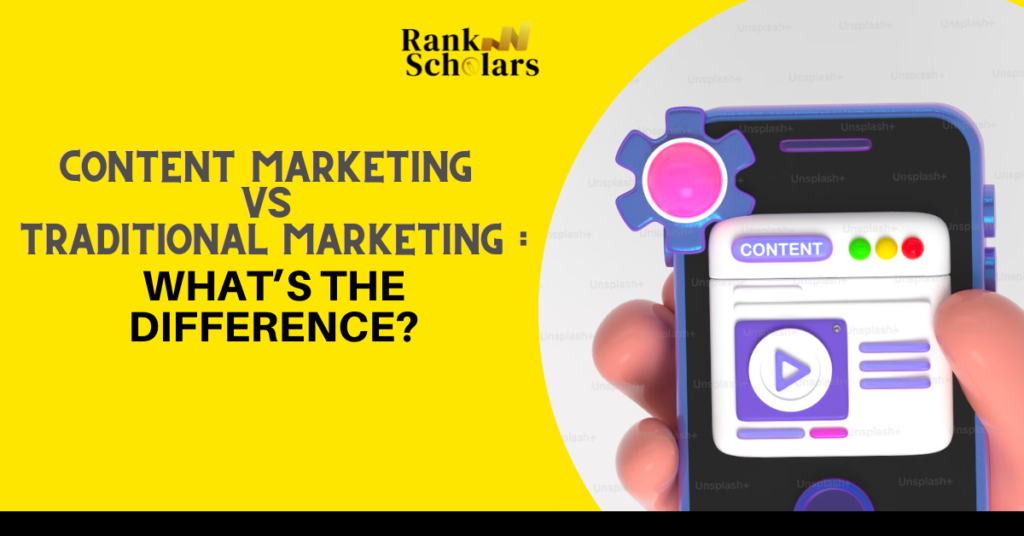Imagine waking up to knowing you lost your online presence that you have been building diligently for years. Immediately, you will get a flash of a knock-out effect on your business. Very often, businesses invest time and resources into creating their brands and stocking them with fantastic products. However, the concern grows when they struggle to attract a loyal customer base.
This nightmare highlights a very real concern for many ecommerce businesses. In a nutshell, if your online store is not reaching its full potential, is struggling with low website traffic, and has weak conversion rates, the reason behind this is a lack of content strategy. Truth be told, if you own an ecommerce store and are neglecting content marketing, it could backfire dramatically.
The key is to build an effective brand image via content marketing. This blog post discusses the major benefits of the same, explaining how a content strategy can help you increase website traffic and engagement, boost sales, and build brand loyalty.
By the end of this blog post, you will come across actionable tips to create a content marketing strategy that drives results for your ecommerce business. That being said, let’s take a closer look at it!

What Does the Data Say Regarding Content Marketing for Ecommerce Brands?
While 94% of B2B small firms use content marketing strategies, only 9% say their efforts are paying off. This is where the technicalities come. The key lies in a strategic approach. While you create content marketing strategies for ecommerce brands, here’s what not to do:
- Fail to create high-quality, relevant content
- Invest peanuts for marketing purposes
- Neglect analyzing and adjusting your strategies based on the performance data
Content marketing isn’t just about creating blog posts and social media updates. It is about developing a solid strategy that speaks directly to your audience’s needs and interests.
Like the Absolute Report says, the content marketing industry is projected to reach $900 billion by 2028. That is what ecommerce businesses can achieve through content marketing. Let’s get down to reading why ecommerce brands should invest in content marketing right away!
Why Should Ecommerce Businesses Focus on Content Marketing?
It is crazy how almost 66% of consumers do online research prior to buying any product. This straightaway signifies that you need to invest in building your web presence and drive organic traffic as much as you can.
In order to direct such customers toward your products or services rather than a competitor’s, you need to level up your digital marketing game. It is more than just creating content. It is a strategic approach to attracting potential visitors and turning them into loyal customers. Here’s how a solid ecommerce content marketing strategy can supercharge your online store:
Builds Brand Authority
Content marketing involves publishing quality content consistently to position your brand as an industry leader. Furthermore, this builds trust, and trust builds authority. As a result, this valuable content builds trust with potential customers, making them more likely to choose you over competitors who lack that expertise.
Drives Organic Traffic via SEO
Higher search engine rankings are a direct result of high-quality content. In return, content marketing efforts only make it easy for potential buyers to locate your online store. The more valuable and search engine optimized (SEO) your content is, the higher you will rank in search engine results pages (SERPs). Result? Organic traffic to your website.
Builds Customer Loyalty
A piece of content that addresses your audience’s pain points and provides legit solutions is phenomenal. This kind of content builds customer loyalty and makes them buy from you again. (because you know their pain points!) In short, it builds a loyal customer base.
Brings in Improved Engagement
Visitors spend more time on your site when they come across engaging content. Think of interactive quizzes, polls, or contests related to your products. Encourage comments and discussions on your blog posts. This two-way communication builds a community around your brand and keeps visitors coming back for more. Eventually, this reduces bounce rates and increases conversion rates.
Promotes Lead Generation
Compelling content doesn’t just attract visitors; it can also capture their contact information (like email addresses). This happens through strategic calls to action (CTAs). Eventually, it allows you to nurture these leads with targeted promotions and convert them into paying customers down the line.
Also Read: How Does Content Marketing Drive Sales?
What Type of Content Works Best for Ecommerce Businesses?
There is no one-size-fits-all approach here. Content creation entirely hinges on the type of business, your target audience, your brand story, and so much more!
However, if there are some winning content strategies that work for ecommerce sites, it could be anything from case studies to podcasts, infographics to YouTube videos, films, and social media posts. Some selling forms of content for an ecommerce store include:
- SEO Blog Posts: These are generally educational pieces of content that handle frequently asked questions, and pain points, and generate organic traffic to your site.
- Infographics: Infographics are visual pieces of content that make complex information easier to understand and are shareable on social media.
- User-Generated Content: This involves reviews and testimonials written by genuine (original) customers that eventually help in establishing credibility.
- Video: This is the most captivating type of content. It involves educational product demos, guides, and reviews from satisfied customers.
- Product Guides: This one is an in-depth guide that provides step-by-step instructions that show buyers how to use your products effectively.
70% of online marketers claim that search engine optimization (SEO) generates more revenue and sales than pay-per-click ads (i.e., Google Ads), further proving that SEO is the most effective digital marketing strategy to date!
What Does an Ideal Ecommerce Content Marketing Strategy Look Like?

Your content marketing plan should directly reflect your brand story. Only YOU are in the best position to understand your consumers’ choices. Eventually, you would understand better, regarding what will truly connect with them.
However, here comes the tricky part. It is not always easy to pen it down to engaging content. As a part of an ecommerce content marketing strategy, you need to analyze certain things first. Have a look!
Understand Your Target Audience and Their Buying Cycles
You need to know how your users search and how it connects to your website before you build a content strategy. Suppose somebody searches for “best gifts for a birthday”. This person’s search intent is different from someone who searches for “best coffee mugs to gift on a birthday”. Again, both are different for a person who is looking for “personalized coffee mugs vs personalized photo frames”.
The initial question indicates that the person is not sure about what gifts might be perfect. The next query is from someone who has a clear idea of what they want and is likely filtering through the availability, stock, color, size, and price. The last query indicates that the person has narrowed down his choices but is still confused and looking for answers to make a final decision.
The trick here is, each of these queries need a different ecommerce content strategy. Buying cycles is another trick for refining your strategy. As any competent marketer can tell you, there are several steps to the sales and buying process.
Actionable Tip: A practical piece of advice would be to learn as much as possible about your target audience. Go for thorough market research, filter through customer data, and develop buyer personas to build a strong content strategy for ecommerce stores.
Audit Your Website and Analyze Competitor Sites
Develop a solid strategy for researching your competitor. All you need to do here is understand your competitor’s position. Visit their website. Check out how they are building their online presence. For example, let’s consider their blog section. Take a look at it. Check:
1. Which blog posts are driving more traffic to their website?
2. What kind of blog posts bring in genuine traffic?
3. What type of blog posts are getting the most shares on the web?
Understand and identify topics that your competitors are talking about. Next, conduct a content audit on your website. Ask yourself:
1. Which content is bringing traffic and which isn’t?
2. Can you curate better content than your competitors?
3. Which page is bringing in more money on your online ecommerce store?
4. Which content is sitting straight with your current marketing goals and targeting your audience requirements, and which isn’t?
Upon successful audit, create a priority page. Without wasting time or energy on content that won’t perform for your target audience, try updating, removing, or revamping the outdated pages as per your content strategy.
Actionable Tip: SEO tools like Semrush or Ahrefs work exceptionally here. You can find out which pages are performing well and which search terms users are using that are directing them to that page. Another tip is adding backlinks. When you link your website to other credible sites, it increases your brand’s and site’s credibility. Result? You rank higher in SERPs!
Create Your Strategy
If you’re just starting out in the content marketing industry, it is better to develop both your strategy and plan at the same time. Knowing your brand’s strengths and capacities is a critical part of planning out a content goal. Your content plan is your strategy, and this strategy will help you take the necessary actions. Here’s how to do it.

Identify the Types of Content to Use
Optimizing your product and category pages is just the beginning of what a content strategy for ecommerce should cover. The best ecommerce websites feature blog posts, images, and videos, along with leveraging the power of social media marketing to attract more customers and boost sales.
For starters, you can optimize your ecommerce site by adding:
- Product image galleries
- Infographics
- “How to” guides/buying guides/ tutorials
- Online print catalogs
- Contests
- Forums
- Product reviews
- Product comparisons
- Gated content
- User-generated content
- Blog posts/Niche-specific articles
- Expert articles
- Sales pages
- Discount/coupon pages
- FAQ page
At the end of the day, prioritizing your audience’s personas and their pain points must be your priority when determining the types of content to invest in. In case you are confused with content creation, head over and review your audience demographic data to find out who you’re writing for and what kind of content might resonate with them.
Create a Content Calendar
After prioritizing topics and deciding on your content type, organize them in a content calendar. Generally, your content calendar must have:
- Content topic
- Content type (video/blog/infographic)
- Accompanying content (add-ons besides the original content, aka images)
- SEO details (title, description, metadata, keywords)
- Target audience
- Authors
- Publish date
Create a Distribution Plan
Coming up with engaging content for ecommerce businesses is pointless if you are unable to promote and advertise it. Take the social media route and distribute your content through more immediate channels and platforms. Here’s how to distribute it:
- Social Media Platforms: One of the best ways to reach customers nowadays is through social media marketing. But first things first, figure out who your actual target audience is, what your goals are through this strategy, and how much time and money you can invest in this campaign. One wrong move and you may end up in a different algorithm targeting the wrong audience.
- Paid Media: Paid media in digital marketing is all about paid social advertisement, pay-per-click advertising, and search engine marketing. Here, your content is promoted to customers via multiple online platforms, including search engines, social media feeds, and more. However, all of it comes at a cost.
- Earned Media: Any kind of advertising or exposure that comes from external sources is considered earned media. Online interactions like retweeting, sharing, liking, mentioning, and more like a “digital” word of mouth. People will spread the word about your brand and content by sharing it on their feeds, which will further reach a wider audience and increase your brand image.
- Email Marketing: Your ecommerce content marketing strategy must include email campaigns. Your email does not promote your latest offers and products only. Instead, make it a direct communication channel with your customers. Send exciting shopping guides, the latest trends, upcoming contests, etc etc. The key is to keep them hooked!
Actionable Tip: Before jumping into content creation, figure out who you are talking to. Ask your customers what they like, and conduct surveys. Listen to what they are saying online. Based on this, create a picture of your ideal customer; their interests, pain points, and what kind of content they dig. This way, your content will be like chatting with a friend, not just another piece out there.
Map Out Short-Term vs. Long-Term Ranking Goals
Remember that you will never be able to rank for all of your target keywords any sooner. Hence, decide on your short-term and long-term goals. The concept is simple. Short-term wins definitely fuel your long-term growth. Here’s how to map both:
Short-Term Goals (3 to 6 months)
Listed below are some of the short term goals that you can build to see long-term growth. This may take 3-6 months, depending on your pace.
- Revamp/update your existing content to keep up with the SEO trends and rank in SERPs. Regularly refreshing your content ensures it remains relevant and aligns with the latest search engine algorithms. This practice not only helps maintain your current rankings but can also improve your visibility for targeted keywords.
- Target “quick win” keywords with low competition and high search volume. By focusing on these keywords, you can achieve faster results and start generating traffic sooner. These quick wins build momentum and create a scope for more competitive keyword strategies in the future.
- Take advantage of seasonal trends by publishing regular content. Keeping an eye on industry-specific trends and seasonal spikes can provide timely opportunities to attract more visitors. Regularly publishing relevant content positions your site as a current and valuable resource for users, which can significantly boost your traffic during peak periods.
Align Short-Term Goals with Long-Term Goals
Once you figure out and work on the short-term goals, it’s time your efforts pay back. Align what you’ve been doing all along with something more. Eventually with time, you will see both your goals aligning with each other and helping you drive massive business growth.
- Try capturing leads with value-packed downloadable resources/content. Offering high-quality, downloadable content, such as eBooks or guides, can entice visitors to provide their contact information. This strategy not only helps in lead generation but also builds a list of engaged prospects for future marketing efforts.
- Market your brand and your expertise through engaging content. Consistently creating and sharing insightful and authoritative content establishes your brand’s credibility and expertise in your field. This not only attracts a loyal audience but also strengthens your site’s authority, which is crucial for long-term SEO success.
- Drive organic traffic to high-converting product pages. By directing your organic traffic to pages that are optimized for conversions, you can maximize the value of your visitors. Implementing effective call-to-action strategies and ensuring a seamless user experience on these pages can significantly enhance your conversion rates, ultimately supporting your long-term growth objectives.

Also, while evaluating your goals, remember:
- When it comes to keyword rankings, backlinks are king. You need backlinks to prove to Google that your site is trustworthy and not just an AI bot. This will help you rank higher in SERPs for a specific keyword.
- Google has made it very clear that buying backlinks is totally against its policies. So, try connecting with a link-building agency to avoid this mishap.
- You don’t have to write a blog post for every keyword. Your ecommerce websites should target your primary keywords. You can write blog posts that target more specialized keywords.
Actionable Tip: Try mapping these goals by using a content calendar to outline your content strategy, both short-term and long-term, graphically. This will guarantee a consistent flow of content even on days you hit blockers.
Review Performance and Pivot for Better Results
Reviewing the performance of your site is the major goal of content marketing. Think about how your ecommerce store performed over the past month or 2 months. Analyze what strategies you can adopt to improve your ranking. In short, here’s how you can review the performance of your online ecommerce store for better results.
- Track Important KPIs: Go through your KPIs. Track conversion rates, website traffic, bounce rate, session duration, keyword rankings, and social media engagement.
- Analyze Your Data: Use expert tools like Google Analytics and Google Search Console to understand how your content is performing.
- Look for Areas of Improvement: Check out which content is not performing as expected. Update/remove them with a better one.
- A/B Testing: Test different CTAs, headlines, and formats to determine what’s working best for you. Once you have this data, try adjusting your content marketing efforts. Cut back on strategies that aren’t generating the desired results and instead focus on areas that are capable of driving the desired results.
Actionable Tip: To ensure the long-term success of your content strategy for ecommerce stores, plan on conducting audits at regular intervals (quarterly or biannually). Use this time to evaluate your website’s performance and make any necessary adjustments.
Common Ecommerce Content Marketing Mistakes to Avoid
Here comes the most awaited part of the blog post. You must know that even the best agencies that offer content marketing for ecommerce brands can fall victim to common pitfalls. However, we’ve done the tough job and listed 5 common ecommerce content marketing mistakes below that you need to avoid at all costs.
Focusing Too Heavily on On-Page SEO
New ecommerce brands pour heavy resources into on-page SEO (improving title tags of the website, header tags, URL structures, etc.) Although these efforts do improve your website’s search engine rankings, they do impact its performance. In clearer terms, on-page SEO solely cannot increase the credibility of your site.
Invest 95% on creating educational content and building backlinks from credible websites until you have 1,000 visitors from search engines in the first month. Long story short, search engine optimization is important, but it will backfire if you focus too much on keyword stuffing and not enough on the content’s quality and value.
Targeting “Best” Terms on Product Pages
Online stores often set their sights on irrational search engine rankings. Using search terms like “best (service/product)” is a prime example. Although being at the top of a search term like “best coffee mugs” would be a fantastic way to boost sales, it is unfortunately quite rare.
The reason is, search intent. When a user types “best coffee mugs” on Google, the search engine assumes they obviously want an unbiased ranking of brands and customer ratings. The user will come across 10 different articles reviewing 10 different coffee mug brands written by an unbiased third party.
Remember, the only way to achieve the best results lies in optimizing your product pages for specific niche and product-related inquiries. This approach is not only smart but also highly effective when it comes to driving targeted traffic to your online store.
Not Investing in Other Facets of Digital Marketing
When it comes to ecommerce stores, content marketing turns the tables in the long haul. However, sticking to one strategy can get frustrating, especially if you want fast results. Hence, there is no harm in trying out different digital marketing strategies like:
- The cost of attracting a single customer via pay-per-click PPC (Google Ads, Facebook Ads) may get high. However, while you build momentum with your SEO initiatives, this is a fantastic investment to increase your customer base.
- Email marketing and SMS marketing. You can consistently sell to your ideal customers via email and text messages.
- Using social media marketing to grow your business is another fantastic idea. By leveraging social media platforms, you can create a loyal customer base and position yourself as an industry leader.
Giving Up on Content Marketing Too Early
If insanity is defined as “ doing the same thing over and over again and expecting different results”, you are running the risk of becoming irrelevant (and subtly setting up your ecommerce store for failure.)
Investing in content marketing takes time, but gives exponential returns. Generally, many brands invest in content marketing for one/two months, wait for sales to improve, and notice little to no difference, and ditch the marketing altogether.
Content marketing for ecommerce brands takes significant effort and time. Do not give up on it too early. As you invest in it, expect a gradual growth in the first 3 months, a little more in the next 4, and a massive one in the next 5 or 6 months.
Key Takeaway
Implementing a successful content marketing strategy can have a major impact on your ecommerce business. However, if you want to attract organic traffic, engage your audience, and increase conversion rates, the key here is to have patience.
If you own an ecommerce store and want to expand your customer base, improve sales, and increase conversions, you need to get in touch with Rank Scholars. Our agency deals in offering personalized content marketing for ecommerce brands. We develop and implement marketing plans that are specifically designed for your brand’s individual requirements. Our goal is to help you stand OUT, not blend IN!
Still not convinced? Contact us and allow us to help you decide if you’d need one!
Sushmita is known for her content clarity, witty engagement, creativity, and formal precision. With half a decade experience in content writing, she loves dissecting the “known yet less-accepted” (topics, not bodies) on medium. When Sushmita isn’t straining her thumbs writing, she’s busy running her solopreneurship.




